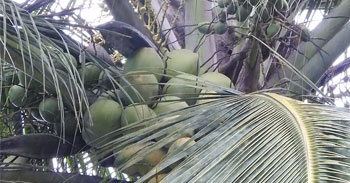KJC Medicinal Garden
Thengina mara
Cocos nucifera
Order: Arecales
Family: Arecaceae
Genus: Cocos L
Species: C. nucifera
Common Names: Coconut palm
Native to coastal areas of Melanesia and South-East Asia
Other plants of the same genus with medicinal properties
-
Chowghat Orange Dwarf Coconut
Golden Malayan Dwarf Coconut
Green Dwarf Coconut
Macapuno Coconut
Fiji Dwarf
VHC1 Coconut
King Coconut
- Cocos nucifera is a large palm, growing up to 30 m (100 ft) tall, with pinnate leaves 4–6 m (13–20 ft) long, and pinnae 60–90 cm (2–3 ft) long
- old leaves break away cleanly, leaving the trunk smooth.
- On fertile soil, a tall coconut palm tree can yield up to 75 fruits per year, but more often yields less than 30.
Uses in Tradition systems of medicine
- Industry is using the husk fiber from the pith as raw material for carpets, car seat stuffing, and in agricultural as fertilizers.
- The hard core is used to make handcrafts.
- The stalk and leaves of the coconut tree are useful in construction, and sugar, vinegar, and alcohol can be extracted from the inflorescence.
- Calories: 283.
- Protein: 3 grams.
- Carbs: 10 grams.
- Fat: 27 grams.
- Sugar: 5 grams.
- Fiber: 7 grams.
- Manganese: 60% of the Daily Value (DV)
- Selenium: 15% of the DV.
Suggested Medicinal Properties
- antibacterial
- antifungal
- antiviral
- antiparasitic
- antidermatophytic
- antioxidant
- hypoglycemic
- immunostimulant
Active Phytochemicals
1. Phytochemical studies of the coconut fiber (mesocarp) ethanolic extract revealed that the presence of phenols, tannins, leucoanthocyanidins, flavonoids, triterpenes, steroids, and alkaloids, while a butanol extract recovered triterpenes, saponins, and condensed tannins.
2. Condensed tannins are reported to possess antihelminthic activity by binding to proteins present in the cuticle, oral cavity, esophagus, and cloaca of nematodes, thus intensifying the physical and chemical damage in helminth.
3. The lyophilized extract and fractions, as well as ethyl acetate extracts, from the C. nucifera fiber are rich in polyphenols, compounds such as catechins, epicatechins, tannins, and flavonoids.
4. Furthermore, oil extracted from the solid albumen is primarily lauric acid and alpha tocopherol.
5. Root phenolic compounds were identified as flavonoids and saponins. Other compounds identified in leaf epicuticular wax were lupeol methylether, skimmiwallin, [3b-methoxy-25-ethyl-9,19-cyclolanost-24-ene], and isoskimmiwallin [3b-methoxy-24-ethyl-9,19-cyclolanost-25-ene].
References
1. Royal Botanic Gardens, Kew. Cocos. World Checklist of Selected Plant Families.
2. Pearsall, J., ed. (1999). "Coconut". Concise Oxford Dictionary (10th ed.). Oxford: Clarendon Press. ISBN 0-19-860287-1.

